Textured Protein Market Summary
The global textured protein market size was valued at $1.1 billion in 2022, and is projected to reach $2.7 billion by 2032, growing at a CAGR of 9.4% from 2023 to 2032. The textured protein market demand has experienced a surge in demand due to a growing interest in plant-based protein alternatives among consumers.
Key Market Trends and Insights
Region wise, North America generated the highest revenue in 2022.
The global textured protein market share was dominated by the chunks segment in 2022 and is expected to maintain its dominance in the upcoming years
The textured soy protein segment is expected to witness the highest growth during the forecast
Market Size & Forecast
- 2022 Market Size: USD 1.1 Billion
- 2032 Projected Market Size: USD 2.7 Billion
- Compound Annual Growth Rate (CAGR) (2023-2032): 9.4%
- North America: Generated the highest revenue in 2022
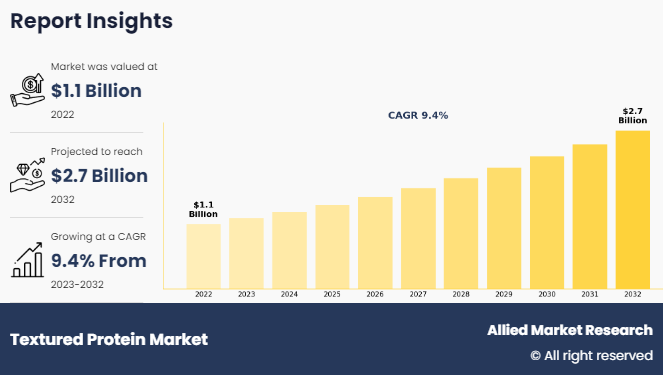
Key Takeaways
By product type, the textured soy protein (TSP) segment was the highest revenue contributor to the textured protein Industry in 2022 and is expected to grow at a significant CAGR during the forecast period.
By form, the granules segment was the highest revenue contributor to the market in 2022 and is expected to grow at a significant CAGR during the forecast period.
By application, the meat alternative segment was the highest revenue contributor to the market in 2022 and is expected to grow at a significant CAGR during the forecast period.
- By region, North America was the highest revenue contributor to the market in 2022 and is expected to grow at a significant CAGR during the forecast period.
Market Dynamics
Textured protein refers to a type of protein that has been processed to have a texture similar to meat. It is made from plant-based sources such as soybeans, peas, or wheat gluten. Through various methods such as extrusion or spinning, these proteins are transformed into fibrous structures resembling meat. Textured protein is often used as a meat substitute in vegetarian and vegan diets or to extend meat products. It is versatile and is flavored & seasoned to mimic the taste and texture of different meats, making it a popular choice for plant-based meals.
The popularity of adopting vegetarian and vegan lifestyles is on the rise and has led to the textured protein market growth. As more people choose vegetarian or vegan diets, they look for alternatives to traditional meat products. Textured protein, derived from plant-based sources such as soybeans, peas, or wheat gluten, provides a meat-like texture and taste, making it a viable solution for those seeking meat substitutes that align with their dietary choices and values.
In addition, the growth of the vegetarian and vegan population has driven innovation in the textured protein market, resulting in the development of new and improved products. Food companies invest in R&D to create textured protein options that mimic the taste & texture of meat and offer nutritional benefits. Consequently, the increase in demand from vegetarians and vegans significantly contributes to the expansion of the market, driving its growth and diversification in the food industry.
More people seek healthier and sustainable dietary choices, which has led them to prefer plant-based options to meet their protein needs. Textured protein is an excellent solution as it imitates the taste and texture of meat while being derived from plants such as soybeans, peas, or wheat gluten. This is particularly appealing to individuals who want to reduce their consumption of animal products for reasons such as health, environmental or ethical concerns.
Furthermore, as the popularity of vegetarian and vegan diets continues to rise, there is an increase in demand for versatile and nutritious meat substitutes. Textured protein is a perfect fit for this demand, providing a protein-rich alternative that is used in a variety of dishes, from burgers to stir-fries. To cater to this growing market segment, food manufacturers invest in the development and marketing of textured protein products, which drives further expansion and innovation in the textured protein market.
The demand for textured protein has witnessed a significant increase due to the growing focus on health and the rising interest in meat substitutes. People have become more health-conscious and seek alternatives to traditional meat products that are often high in saturated fats and cholesterol. Textured protein is derived from plant-based sources such as soybeans, peas, or wheat gluten, and offers a nutritious and protein-rich option. These substitutes provide a healthier alternative to meat while still delivering essential nutrients, making them appealing to health-conscious consumers.
In addition, concerns about the environmental impact of meat production have fueled the demand for textured protein. As individuals become more aware of the sustainability issues associated with conventional meat consumption, they turn to plant-based alternatives such as textured protein. These substitutes require fewer resources to produce and generate lower greenhouse gas emissions compared to traditional meat, aligning with the values of environmentally conscious consumers. As a result, the combination of health consciousness and sustainability concerns has propelled the growth of the textured protein market, driving increased adoption and innovation in the industry.
Moreover, there is a growing interest among consumers in the market for textured protein due to the increase in environmental concerns related to meat production. As people become more aware of the significant environmental impact of meat production, such as deforestation, greenhouse gas emissions, and water pollution, they look for alternative and more sustainable protein sources. Textured protein, which is derived from plants such as soybeans, peas, or wheat gluten, is an ideal solution as it uses fewer natural resources and emits fewer greenhouse gases compared to traditional meat production.
Moreover, the production of textured protein typically involves less land use and water consumption, making it a more environmentally friendly choice. As consumers increasingly prioritize eco-friendly options in their diets, the demand for plant-based protein alternatives is growing, and food companies are responding to this by innovating and expanding their offerings. This trend is driving the growth of the market.
The development of novel flavors and varieties presents significant opportunities in the textured protein market. By offering a wide range of flavors and varieties, manufacturers cater to diverse consumer preferences and dietary needs. For example, introducing flavors such as barbecue, teriyaki, or spicy chipotle appeal to consumers seeking familiar tastes and enhance the overall sensory experience of textured protein products. In addition, creating variations such as burger patties, meatballs, or sausages provides versatility in meal options and encourages consumer experimentation with plant-based alternatives.
Moreover, the development of innovative flavors and varieties boost demand for textured protein and drive growth. Unique flavor profiles and product formats differentiate textured protein products from traditional meat options, appealing to health-conscious individuals, vegetarians, and flexitarians alike. This expansion of options increases market penetration and encourages repeat purchases as consumers discover new and exciting textured protein offerings that suit their tastes and preferences.
However, allergies or sensitivities to certain plant-based protein sources commonly used in textured protein products, such as soybeans or wheat gluten, limit the appeal of textured protein among consumers. This poses a significant restraint on the demand for the textured protein market. Food manufacturers face challenges in marketing and selling their textured protein products to a wider audience, particularly those with food allergies or intolerances.
Moreover, allergenicity concerns lead to increased scrutiny and regulation from food safety authorities. This requires manufacturers to invest in rigorous testing and labeling practices to ensure compliance with allergen labeling laws. These additional regulatory requirements add complexity and cost to the production process, further inhibiting the growth of the textured protein market.
Segments Overview
The textured protein market forecast is segmented into product type, form, application, and region. By product type, the market is classified into textured soy protein (TSP), textured wheat protein (TWP), and textured pea protein (TPP). By form, the market is divided into slices, flakes, granules, and chunks. By application, the market is segregated into meat alternatives, meat extenders, soups & stews, snacks, cereals, bakery products, and others. By region, the market is analyzed across North America, Europe, Asia-Pacific, LA, and MEA.
By Application
The meat alternative segment accounted for a major market share in 2022 and is expected to grow at a significant CAGR during the forecast period. There is an increasing awareness among consumers about health and sustainability which is driving demand for plant-based meat substitutes. Secondly, advancements in food processing technologies have enabled manufacturers to create textured protein products that closely resemble the taste and texture of meat, making them more appealing to a broader consumer base. Moreover, the growing availability of meat alternative products in retail outlets and food service establishments has further fueled the segment's growth, making it a dominant force in the textured protein market size.
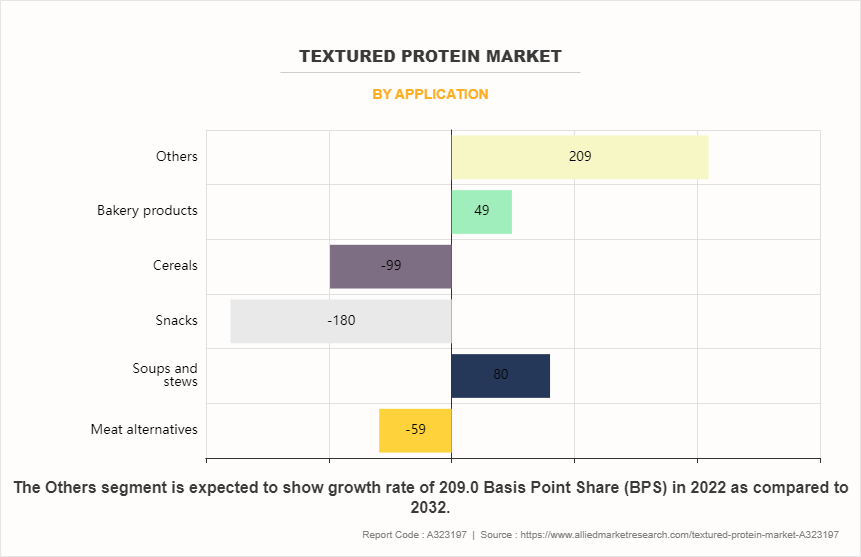
By Form
The granules segment accounted for a major textured protein market share in 2022 and is expected to grow at a significant CAGR during the forecast period. The granules segment has a significant share in the market, owing to its versatility and wide range of applications. Granules are a convenient form for food manufacturers as they are easily incorporated into various products such as burgers, nuggets, and sausages. They provide a meat-like texture and absorb flavors well, making them popular among consumers who seek meat alternatives. Moreover, granules are often preferred as they mimic the appearance and mouthfeel of meat, contributing to their significant market presence and continued growth.
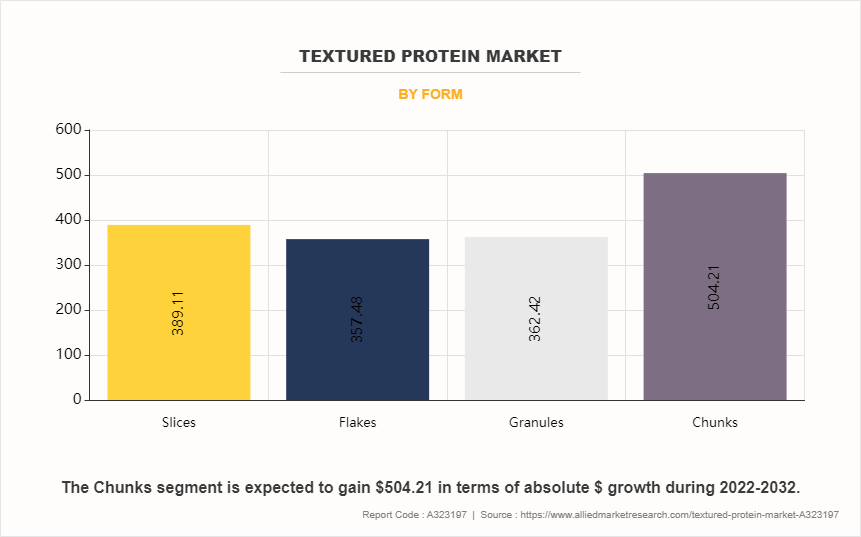
By Product Type
The textured soy protein segment accounted for a major textured protein market share in 2022 and is expected to grow at a significant CAGR during the forecast period. Textured soy protein is a popular and widely used plant-based protein in the market. It holds a significant share in the market due to being a complete source of essential amino acids. Soy is very flexible and is processed into different textures and forms, making it suitable for a wide range of applications, from meat substitutes to dairy alternatives. Moreover, soy is relatively cost-effective compared to other plant-based proteins, making it a popular choice among food manufacturers looking for affordable protein sources for textured protein products.
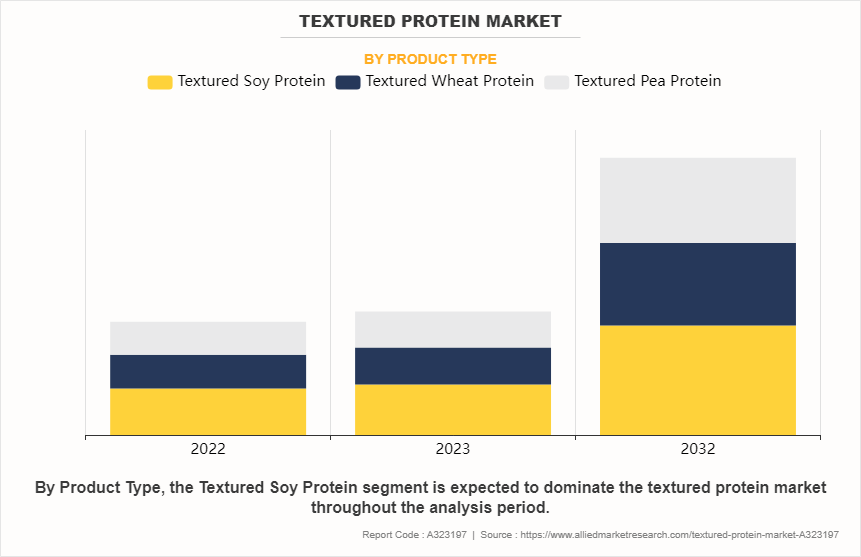
By Region
North America accounted for a major market share in 2022 and is expected to grow at a significant CAGR during the forecast period. There has been a notable increase in the popularity of plant-based diets due to growing concerns about health and the environment. North America has a well-developed food industry infrastructure and modern technology that makes it easier to produce and distribute textured protein products. The market is dominated by a variety of meat alternative options that are widely available thanks to extensive marketing efforts. In addition, favorable government regulations and increased consumer acceptance of plant-based foods further cement North America's position as a leading player in the textured protein market.
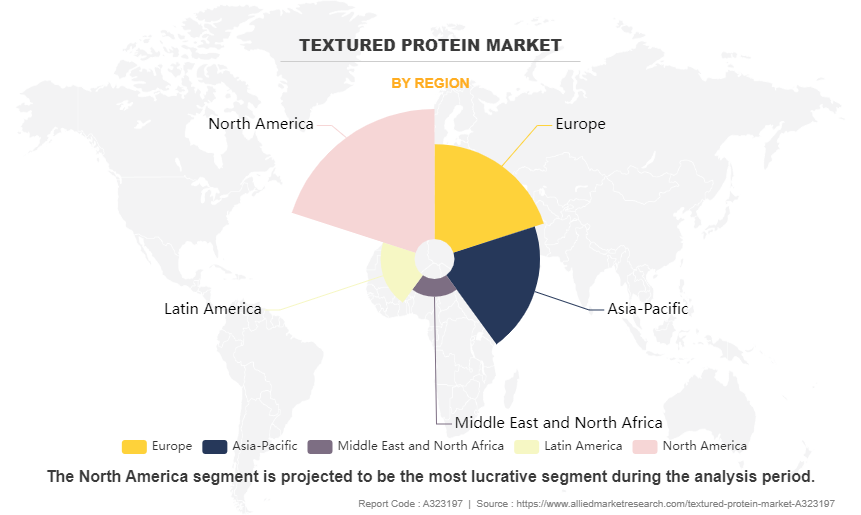
Competitive Analysis
Major players such as British Foods PLC, Bob’s Red Mill Natural Foods, Ingredion Inc., Roquette Frere, and Vippy Industries Ltd have adopted product approval, partnership, agreement, and acquisition as key developmental strategies to improve the product portfolio of the textured protein market.
Recent Developments in the Textured Protein Industry
In June 2023, Roquette Frères unveiled the inauguration of Roquette’s Food Innovation Center, offering formulators an array of capabilities such as technical and R&D support, cutting-edge equipment, labs, and scale-up testing. The primary objective of the center is to stimulate innovation and expedite the introduction of new products to market.
- In May 2023, Bunge Limited established a strategic alliance with Nutrien Ag Solutions, the retail arm of Nutrien Ltd., to assist U.S. farmers in adopting sustainable farming practices to enhance the production of low-carbon products.
Key Benefits for Stakeholders
- This report provides a quantitative analysis of the market segments, current trends, estimations, and dynamics of the textured protein market analysis from 2022 to 2032 to identify the prevailing textured protein market opportunities.
- Market research is offered along with information related to key drivers, restraints, and opportunities.
- Porter's five forces analysis highlights the potency of buyers and suppliers to enable stakeholders to make profit-oriented business decisions and strengthen their supplier-buyer network.
- In-depth analysis of the textured protein market segmentation assists in determining the prevailing market opportunities.
- Major countries in each region are mapped according to their revenue contribution to the global market.
- Market player positioning facilitates benchmarking and provides a clear understanding of the present position of the market players.
- The report includes an analysis of the regional as well as global textured protein market trends, key players, market segments, application areas, and market growth strategies.
Textured Protein Market Report Highlights
| Aspects | Details |
| Forecast period | 2022 - 2032 |
| Report Pages | 432 |
| By Application |
|
| By Form |
|
| By Product Type |
|
| By Region |
|
| Key Market Players | ADM, Shandong Yuxin Biotechnology Co., Ltd, MGP, The Scoular Company, Foodchem International Corporation, DuPont, Axiom Foods Inc., Cargill Incorporated, Kansas Protein Foods LLC, beneo |
Analyst Review
According to the insights of the CXOs, the global textured protein market is expected to witness robust growth during the forecast period. This is attributed to the food industry's expansion into new markets. It is a significant factor in the increasing demand for textured protein. As food companies explore new regions and demographics, they encounter a wide range of consumer preferences and dietary habits. Many emerging markets have become more aware of health and environmental issues, leading to a growing interest in plant-based diets and alternatives to traditional meat products. Textured protein provides a solution for these consumers, offering a sustainable and nutritious option that mimics the taste and texture of meat. Moreover, investment in R&D of new textured protein sources plays a pivotal role in driving market demand for textured protein products.
CXO further added that there is a rise in concern about animal welfare, and people have become more aware of the ethical issues surrounding traditional meat production. As a result, there is a surge in demand for cruelty-free alternatives such as textured protein. Textured protein is a plant-based alternative that offers consumers the opportunity to enjoy meat-like products without causing harm to animals. This ethical consideration is prompting many individuals to switch to textured protein as a more compassionate choice. However, there is a concern that the market demand for textured protein products is limited due to consumer skepticism about genetically modified organisms (GMOs). Genetically modified crops have been associated with potential health and environmental risks, which has made some consumers wary of GMOs. As a result, some people prefer to consume products made from non-GMO sources, resulting in a decreased demand for textured protein options that are derived from genetically modified plants such as soybeans. This skepticism limits the growth of the market as consumers opt for alternative protein sources that they perceive as safer or more natural.
The global textured protein market size was valued at USD 1.1 billion in 2022, and is projected to reach USD 2.7 billion by 2032.
The global textured protein market is projected to grow at a compound annual growth rate of 9.4% from 2023-2032 to reach USD 2.7 billion by 2032.
The key players profiled in the reports includes The Scoular Company, Kansas Protein Foods LLC, ADM, Foodchem International Corporation, MGP, Cargill Incorporated, Shandong Yuxin Biotechnology Co., Ltd, beneo, Axiom Foods Inc., DuPont.
North America dominated in 2022 and is projected to maintain its leading position throughout the forecast period.
Rise in Vegetarian and Vegan Lifestyles, Health Consciousness, Sustainability Concerns, Innovation and Product Development, Increased Versatility and Consumer Preferences majorly contribute toward the growth of the market.
Loading Table Of Content...
Loading Research Methodology...



